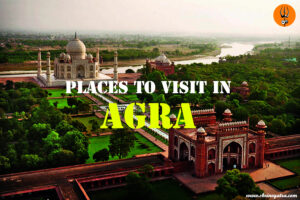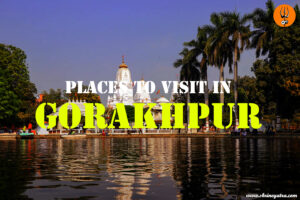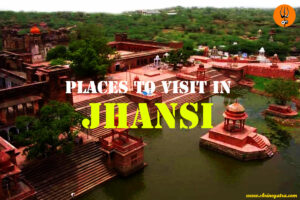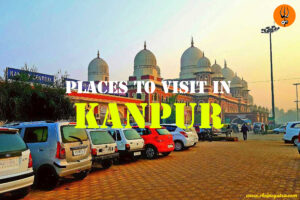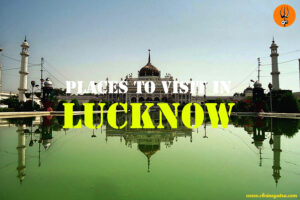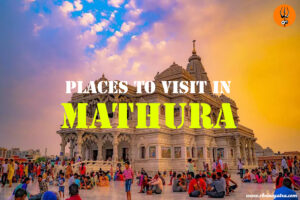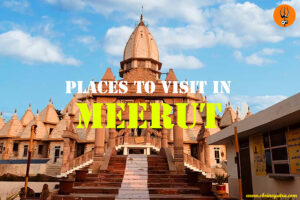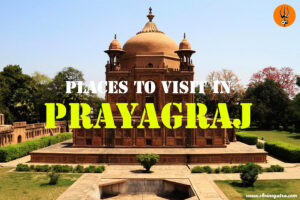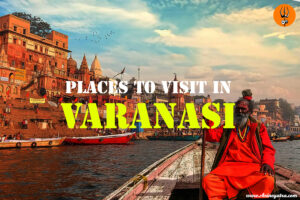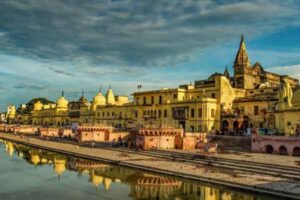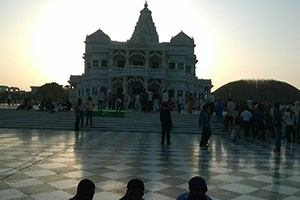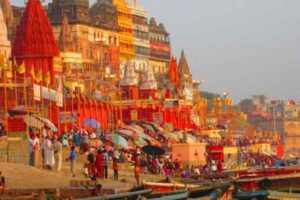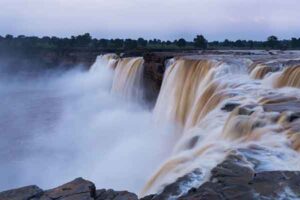Places to Visit in Ayodhya

Steeped in mythological, historical, and sacred context, Ayodhya exists within Uttar Pradesh. Central to Hinduism, Ayodhya is celebrated for being the birthplace of Lord Rama. Paying homage requires visitors to travel to the revered Ram Janmabhoomi Temple located inside the metropolis.
Historical landmarks including the Babri Masjid and the Hanuman Garhi temple showcase a unique combination of Mughal and Hindu design principles, emphasizing the region's complex heritage. From far and wide, Ayodhya draws those interested in spirituality; at the same time, its festive atmosphere fascinates vacationers.
In this article, we will take you on a journey through the famous places to visit in Ayodhya, giving you a glimpse into the spiritual (famous temple in Uttar Pradesh) and historical wonders that await you.
- Best Time to Visit: October to March
- Ideal Vacation Duration: 1 to 2 days
- Places to Visit:Ram Janmabhoomi, Kanak Bhawan, Nageshwarnath Temple, Hanuman Garhi, Gulab Bari, etc.
- Things to Do: Explore the historical heritage and visit temples and museums.
- How to Reach: Via air, rail and road.
Here are some popular places to visit in Ayodhya:
- Ram Janmabhoomi
- Kanak Bhawan
- Nageshwarnath Temple
- Hanuman Garhi
- Gulab Bari
- Treta Ke Thakur
- Sita Ki Rasoi
- Choti Chawani
- Tulsi Samarak Bhawan
- Raja Mandir
- Ram Katha Park
- Dashrath Bhawan
- Mani Prabhat
1.) Ram Janmabhoomi
Considered sacred by devotees, Ram Janmabhoomi marks the place where Lord Ram was born. The tale goes that Ram, an embodiment of Lord Vishnu's seventh avatar, developed alongside Ayodhya's river Sarayu. A sacred location for Hindu followers, the Ram Janmabhoomi commands immense devotion.
Two kilometres separate Ayodhya's city core, where Ram Janmabhoomi is located. Known alternately as the Faizabad Airport in Faizabad, the Ayodhya Airport is situated around 8 to 10 kilometres from the Ram Janmabhoomi. Within a quarter hour to an hour, one can reach this place through a short drive.
Located around 1.5 to 3 km from Ayodhya Railway Station, the destination can still be reached via a short trek of approximately 20 minutes. Of Ayodhya's bus stations, the most prominent one is the Ayodhya Bus Station situated near Ram Katha Park. Measuring 1.7 to 2.5 kilometres apart from Ram Janmabhoomi, this bus stop exists. Bus stands can be found at Faizabad Cantonment and Rajkiya Uddyan Cantonment Road, alongside the Circuit House.
2.) Kanak Bhawan
Located inside Tulsi Nagar, near the northeastern corner of the Ram Janmabhoomi stands Kanak Bhawan. Built in 1891, the temple is commonly called Sone-ka-Ghar. A holy site, this is where Lord Rama and Goddess Sita are revered. Also known as Golden Palace, Kanak Bhwan highlights three gold-adorned statues protected by a silvery roof inside the inner sanctorum. Popular tradition holds that Kaikeyi gifting this shrine to Rama and Sita.
Under Vikramaditya's leadership, the site received a complete overhaul, courtesy of VrishBhanu Kunwari's meticulous design plans. Privately owned by the Sri Vrishbhan Dharma Setu Trust Private Limited, this Bundela-temple is currently being managed.
3.) Nageshwarnath Temple
With Lord Nageswanth at its core, the Nageshwarnath Temple resides next to the bustling Theri Marketplace within Ayodhyas limits. By Kush or Kusha, Lord Rama's son, it is said that this was established. From 750 AD until now, the place remained properly cared for; but according to historical records, Navy Rai, serving under Safar Jung, completely overhauled the structure around 1750 CE. Myth has it that upon discovering Naga Kanya, who was deeply devoted to Shiva, Kush had lost his arm ring at a neighbourhood bathhouse.
Learning about her affection towards him, he constructed the Shiva temple as an act of devotion. A popular pilgrimage site in southern India, the Nageswara Temple sees large crowds during Mahashivaratri and Trayodasi. A major draw for visitors, the Shiva Barat celebration honours Lord Shiva.
4.) Hanuman Garhi
Dedicated to the Hindu deity Hanuman, the 10th-century Hanuman Garhi Temple is situated in Sai Nagar. Customarily, those interested in seeing Ayodhya begin their pilgrimage at Hanuman Garhi and then proceed to the Ram Temple. At the temple site where he watchfully protects Ayodhya, Lord Hanuman is said to live.
Seventy-six stairs form the route leading to the temple's entry point, situated on a hill. Tucked away amidst the stunning scenery of the nearby mountainside lies a tiny statuette of Hanuman, mere inches high. With multiple statues of Lord Hanuman and his mother Maa Anjani, the main temple's interior cave is quite impressive. Devotees come together at Hanuman Garih to mark the birth anniversaries of Lord Ramb and Lord Hanuman, drawing large crowds.
5.) Gulab Bari
Located in Vaidehi Nagar, the Garden of Roses goes by another name - the Gulab Bari. This monument honors the memory of Nawab Shuja-ud-Daula and his parent's burial site, who were the third Nawabs of Faizabad (Oudh or Awdad). Encompassed by an abundance of roses, fountains, and thriving flora, the historic Gulab Bari boasts an impressive display of Nawab-inspired design from the 18th century. Under the auspices of the Ancient Monuments and Archaeological Sites and Remains Act, Gulab Bari continues to thrive as an integral component of Indian culture.
6.) Treta Ke Thakur
Housing multiple icons, including depictions of Lord Ram, Sita, Lakshman, Hanuman, Bharat, and Sugreev, the Treta Ke Thakur Temple lies near Ayodhya's Naya Ghat. Single blocks of black sandstone were used by ancient artists to create these statues according to legend. Legend has it that Treta Ke Thakur was erected around 300 years ago through the efforts of King Kullu.
Tradition has it that Lord Rama staged the illustrious Ashwamedha Yagna at this location. Renovated during the 1700s, the temple was overseen by Ahilyabai Holkar. On just one day throughout the year, Ekadashi marks when the place opens up to the general population. On the Hindu calendar, this day is commemorated on the eleventh day of the Shukla Paksha in October/November. A blend of vivid revelry and time-tested rituals define this special occasion.
7.) Sita Ki Rasoi
According to legend, Sita ki Rasoi was used by Goddess Sita during her stay near the Janma Honu in Ayodhya's Rajkot region. Nearby the Ram Janmabhoomi, this holy place houses show objects. Sita's name is shared by two kitchens; here resides one of them in the basement.
On the far side lie the extravagantly dressed idols of Hindu deities Ram, Lakshman, Bharat, and Shatrughan, alongside their spouses Sita, Urmila, Mandavi, and Srutakirti. Sita, anointed by the title Goddess Annapurna, enjoys divine worship as the Divinity of Nourishment. Offering free food, the temple sticks to this tradition. Any charitable contribution can be made here by visiting tourists.
8.) Choti Chawani
A majestic edifice made entirely of white marble, Choti Chawni goes by several names, including Maniramdas Chawni and Valmiki Bhawan, situated in Ayodhya. With such breathtaking charm, no words are needed; simply experience this place and let a single sigh convey your emotions.
It becomes clear when analysing this information that there are exactly 34 heritage caves in question here—with 12 found in the south, 17 in the middle (Hindu), and the final 5 up North (Jain). Cavernous structures receive extra layers via the inclusion of Kailasa Temple.
9.) Tulsi Samarak Bhawan
Founded to honour 16th-Century Saint Poet Goswami Tulsidas, who allegedly authored the epic Hindi poem "RamacharitaManas" here at the Tulsi Smarak Bhawan. At Raj Gang Crossing in Ayodhya, located along the eastern stretch of the National Highway, the Smarak was erected in 1969 during the tenure of Governor Sri Vishwanath Das. Alongside the impressive library containing a wealth of written material, the Smarak harbors a reputable research institution named the 'Ayodhya Research Sansthan'.
Investigations into Ayodhya's cultural heritage, literature, and spiritual traditions are conducted via scholarly inquiry. Alongside displaying Ramayana art and craft, the centre offers a daily rendition of Ramkatha. Celebrated with much flair and show, Tulsi Jayanti falls on every 7th of Shravan.
10.) Raja Mandir
Throughout history, Raja Mandir in Faizabad has been connected to different mythic narratives situated alongside river Ghaggar (Sarayu). Within the temple dwells an array of beautifully crafted statues, donned with lavish textiles and precious accessories, symbolising numerous Hindu Divinities. Exquisitely constructed and emblematic of Hindu architecture's splendor, the edifice shines brightly.
Originally famous for being connected to Lord Sri Ram, this temple is currently inhabited by diverse idols and no longer carries that same special significance. Positioned so near to the riverbank, Raja Mandir offers breathtaking views of the temple reflecting off the water's surface, providing an unparalleled visual treat.
Devout believers flock to this location annually, trusting that immersing themselves in the river's holiness can wash away their moral shortcomings.
11.) Ram Katha Park
Located in Ayodhya, this lovely park, known as Ram Katha Park, showcases open-air amphitheatres and lush greenery. A large area of land hosts various activities including devotional programs, festivities, lectures, concerts, poetic expressions, and scriptural readings. Evening hours find Ram Katha Park transformed into either a kid-friendly playground or a serene oasis for grown-ups.
By fostering collaboration between artists from different countries, the institution promotes cultural exchange while nurturing artistic talent within and beyond national boundaries. Elegant by nature, the amphitheatre has emerged as an ideal retreat from the cluttered cityscape.
12.) Dashrath Bhawan
The home of King Dashrath, who ruled Ayodhya and was father to Lord Sri Ram, is Dashrath Bhavan. Bada Asthan or Badi Jagah, Dashrath Mahal boasts extraordinary shrines celebrating King Ram's legacy. Said to have sheltered King Dasharath's kingdom and the young Lord Rama during his growth stages, this lovely palace showcases a magnificently adorned entryway displaying elaborate designs. Chanting mantras, the monks inside the palace dance and sing in unison.While not as grandiose as a royal residence, Dashrath Bhavan remains popular among revellers throughout events such as Ram Vivah, Karthik Mela, Diwali, Ram Navami, and Shravan Mela.
13.) Mani Prabhat
At an altitude of roughly 65 feet, Mani Parbat is a minor peak situated in Kami Ganj area of Ayodhya. Not only does the Parbat provide a picturesque view but is also where you'll find a stupa built by Emperor Ashoka and a Buddhist monastery. Nearby Sugriv Parbat, Mani Parbat contains various religious shrines. Mani Parbat's base houses an Islamic mausoleum.
Conclusion
Ayodhya stands as a timeless testament to India's rich cultural and religious heritage. This historic city, revered as the birthplace of Lord Rama, holds a special place in the hearts of millions of Hindus worldwide. Its landscape is dotted with temples, including the iconic Ram Janmabhoomi Temple, serving as a pilgrimage site and a symbol of devotion. Ayodhya's blend of Mughal and Hindu architectural influences, as seen in structures like Kanak Bhawan and Hanuman Garhi, reflects its diverse history.
Moreover, the tranquil ghats along the Sarayu River and the vibrant festivities make Ayodhya not just a religious hub but also a captivating destination for those seeking spirituality, history, and cultural richness in one place.
